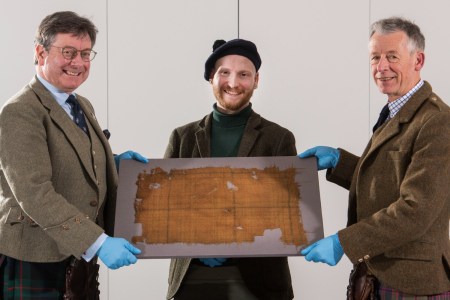A chemical analysis performed on pieces of hair located in a cave off the coast of the Mediterranean showed evidence that people ingested plants containing “mind-altering and vision-inducing substances,” reports Science News. Researchers said this is the oldest direct evidence of people taking hallucinogenic drugs in Europe.
The cave, Es Càrritx in Menorca, Spain, has signs of human activity that date back to between 2,800 and 3,600 years ago. Inside of the cave, researchers found 200 human graves and a small pit in an inner chamber that held six wooden containers keeping the human hair strands. They also found four wooden spatulas, four wooden canes, one wooden stick, a bronze blade and a bronze hairpin, among other items.
Scientists Just Named the Oldest Tartan in Scotland
It’s likely between 400 and 500 years oldThe chemical analysis done on the hair showed samples of atropine and scopolamine, which are substances from nightshade plants. Science News reports that these substances “induce disorientation, hallucinations and altered physical senses” and were often associated with witchcraft during the Middle Ages and Early modern period. They can also induce out-of-body experiences and sensations of skin alterations, such as growing fur or feathers, the researchers wrote.
Ephedrine, the third substance found, works “similar to adrenaline,” the researchers wrote, boosting energy and alertness. The research also showed that these substances were ingested and absorbed in the hair for at least a year after consumption.
Researchers speculate that these people may have been shamans who performed spiritual and healing rituals, as they would have known how to safely consume and use the toxic plants.
Es Càrritx went through social changes sparked by its growing population between 3,000 and 2,800 years ago, and researchers speculate that people interested in preserving ancient traditions during this time hid hair and ritual-specific objects. Burial rituals involved dyeing strands of hair on corpses’ heads and cutting some off to leave in containers near the graves, Science News reports.
“In this context, in the cave of Es Càrritx, some individuals reluctant to abandon ancient traditions, concealed a collection of ritual objects belonging to certain members of the community, possibly shamans, in the hope that the former social order could be re-established in the future,” the researchers wrote. “And the best location to assure the protection of the assemblage was found going deeper inside the burial ground of the ancestors.”
The researchers wrote that this allowed them to “probe into the medicinal and ritual realms of indigenous inhabitants of the Western Mediterranean,” opening doors to new research that reveal more details about plant drug consumption in Europe — specifically in psychoactive species.
Thanks for reading InsideHook. Sign up for our daily newsletter and be in the know.



















